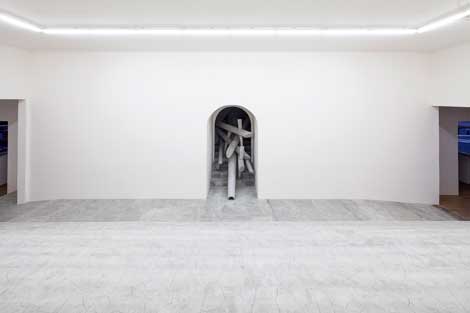“La Inocencia de los Animales” is a staging of our anxiety regarding our continued survival as a species. The installation piece by Adrián Villar Rojas, one module of “Expo 1: New York” curated by Triple Canopy, is presented in a larger collection of work that explores “ecological challenges” and 21st century “economic and sociopolitical instability.” Added to the apprehension produced by this instability, according to their brochure, is a sensibility which recognizes that Modernism failed to regard the environment. Triple Canopy calls their approach, molded by these pressures, “Dark Optimism”—essentially a mixture of fear, suspicion, expectation and disappointment. These unresolved feelings and responses exist in the perpetual state of psychic, colloidal suspension we experience daily as anxiety: a sense that we are moving steadily towards a precipice, beyond which lies the unknown, while other paths seem to offer rescue, but may be illusory.

Adrián Villar Rojas. La inocencia de los animales. 2013. Courtesy the artist and Marian Goodman Gallery, New York, Paris; and Kurimanzutto, Mexico City. Installation view of EXPO 1: New York at MoMA PS1. Photo: Matthew Septimus.
“La Inocencia de los Animales” is a large theater space with adjoining rooms, fashioned in concrete and mixed with unfired clay, ash-white, all cracked and fissured. The entire installation might be a piece of an earlier civilization discovered in situ, one stratum several layers beneath our own. It contains steps radiating upwards from a proscenium, and in the middle of the “stage” a doorway, out of which sprout beams at random angles like branches erupted from the earth’s inside. On either side of the stage are rooms with haphazard spare parts: rings, unhollowed bells, horns, triangles, spare sets of stairs and giant roof shingles. This installation could as easily be a clichéd Hollywood movie image of tomorrow’s world: the aftermath of a viral outbreak that kills half the population, or a zombie apocalypse that turns us into flesh-eating automatons. This piece is more fearful fantasizing about our direction, already set in motion by previous errors, and similarly tends to blend past and future into an indistinct space/time mélange. Still, our (anxious) self-awareness is the chief concern, Villar Rojas suggests.
The crucial element of this installation is a focus on our consciousness. We see this in the centrality of the theater motif in the installation. Additionally, “La Inocencia” is used throughout the run of “Expo 1” as a lecture and performance space. Here the mechanism of knowledge transmission, the theatrical space with its presumed audience and act of storytelling, is the enduring sign of consciously devised civilization. The impulse to define and shape where we have been and what we have accomplished form our histories, and the desire to escape them ignites our fantasies of collapse. We are the animals who are not innocent. Consciousness, our enduring superego, made it possible to develop our current level of industrialized sophistication, and simultaneously makes us world-weary because we cannot or will not undo it. Moreover, this consciousness allows us to abstract ourselves: we are the (guilty) animals who look in the mirror with shame and wonder, while setting ourselves the task of devising our own ending.


